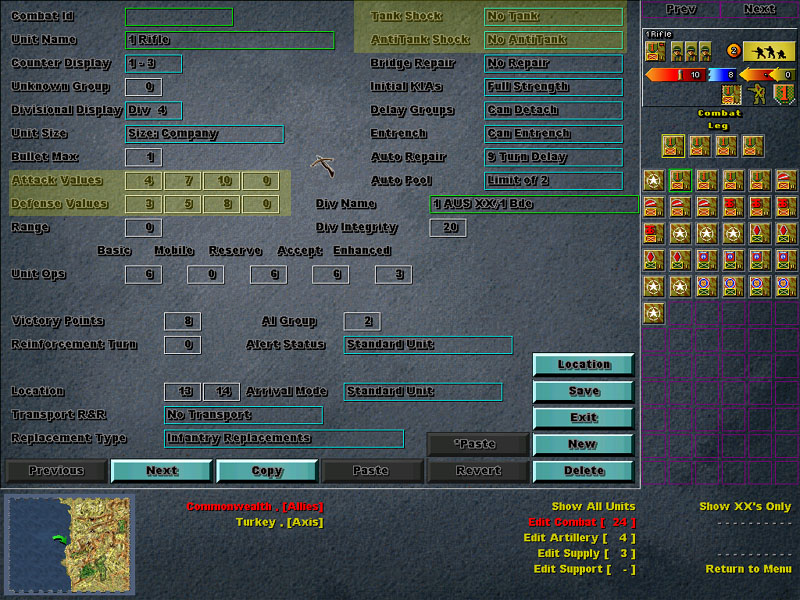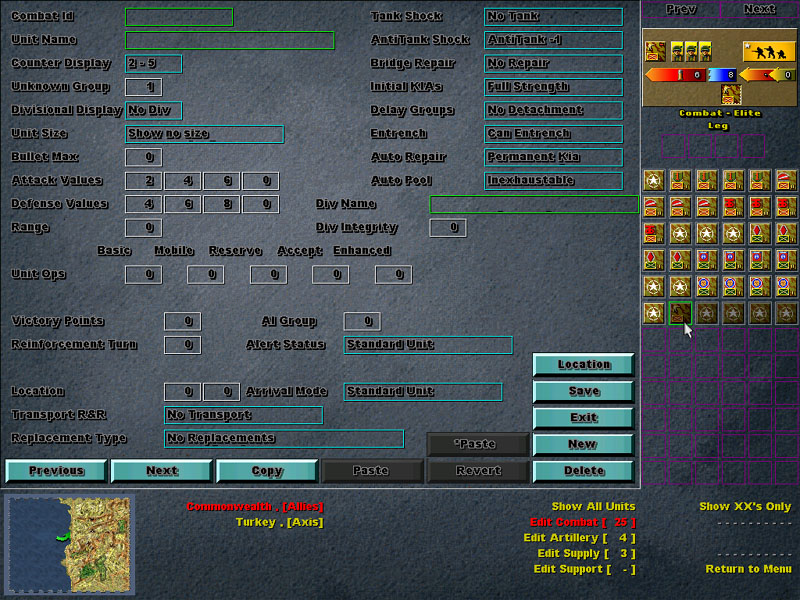
In this tutorial we look at enabling the Unknown Units functionality. It is important that before you commence this tutorial that you have read through the other Scenario Editor Tutorials to date.
One of the features of Korsun Pocket is to commence a game with the Unknown Units setting set to On or enabled. What this feature does is that it randomises the attack and defense strengths of combat units in the scenario. This means that with this setting enabled, each time you play the scenario the units values (for combat units only) may be slightly different from the last time it was played. This feature adds some randomness to the scenario and reduces the 'predictability 'of the game - used correct it can be quite a powerful and interesting feature.
This tutorial will show you how to add the Unknown Units functionality to your own user created scenarios - and its not that difficult!
But first the theory.
Each unit in the game must be assigned to an 'Unknown Group'. To this we can create some additional 'phantom' units which are not used in the game but which are used to form a pool of additional units assign to an Unknown Group. For example lets say we have 5 units that are used in the game which we assign to Unknown Group 1 - and to that we create an additional 6 'phantom units' that are not used in the game, but rather are used only to assign to the same Unknown Group 1 pool. So in total we have 11 units assigned to Unknown Group 1. Five of these units are units which are used in the game, and 6 of these are units which are not used in the game, but act as part of the Unknown Unit database.
What? Sound confused? That's ok, stay with me and it will all fall into place.
When you start a scenario and set the Unknown units setting to On or Enabled - then all active units attack and defense values (along with some other settings which I will go into later) are randomly selected from the available units in their unknown groups. In other words, the 5 units that we use in the game that are in 'Unknown Group 1, will have their values randomly selected from the 11 available units that are in Unknown Group 1. So in other words, the 5 game units values could be chosen from and based upon the 6 phantom units from Unknown Group 1.
Follow the logic? So simply put, when starting an Unknown Units game, all units values will be randomly selected from the pool of values available from the units in their respective Unknown Groups.
Lets look at a variation to this theme. What would happen if we just placed the 5 units by themselves in their own unknown group and didn't create any additional 'phantom' units. Well That's simple. When an unknown units game was commenced, then all 5 units values would still be selected - but only from the 5 units already existing in the pool. In other words all 5 units would randomly swap their values with each other - but all 5 would be used. In other words, Unit 1 may end up with unit 2's values, unit 3 could have unit 5's values, etc.
I think you get the idea. Its quite simple.. and easy to grasp once you understand, and with a little planning it can make for some very interesting playing - based upon the settings you enter into the editor.
Lets now look at how you go about making it all work in the Scenario Editor.
Start up the Scenario Editor and load up your Scenario. Now go to Edit Units and select one of your sides unit databases. Click on Edit Combat to restrict the view to Combat units only and also so that it brings up the Combat Units data entry screen in the main frame. Your screen should look similar to that below:

Now you need to assign each Combat unit to an Unknown Group (see the field That's highlighted in Red above). The rules are doing this are simple - you cant have more then 50 units in one unknown group. And That's it!
But before you start here are some things to think about. If you are going to create some 'phantom units' (which we will do below) you need to make room for these in each of your groups - in other words don't fill all of your groups up with 49 active units as this will only leave room for 1 phantom unit for that group!
Also, it is advisable to plan your Unknown Groups out a little bit. Only put similar units into the same groups. Don't mix INF and ARM into the same group - as you probably don't want INF to end up with ARM attack values and vica versa. Using the same philosophy, only put similar strengthened units into the same groups.. you don't want a force like the 101st swapping values with the 2nd Italian Home Guard (no offense intended to the Italians or the home guard!). So think about your groupings! And generally I would think it is probably better to have more smaller unknown groups then it is to have less larger groups.
Lets now look at what specifically gets swapped or randomised with unknown units enabled. The following items are those which will be swapped between units - if its not highlighted yellow below, then that data stays with the original unit:

So therefore only the following values are 'swapped/randomised' when 'Unknown Units is enabled. That's the Attack Values, Defense Values, Tank Shock Values and Anti Tank Shock Values. All of the other values will not change for the units. So in other words, the 101st, or any other unit will always have the same movement allowance, divisional integrity, hex location, arrival turn etc.
Ok so far so good.. we have put all of our 'similar' units into the same Unknown Group - and we now understand what values will be exchanged between the units each of their respective groups. Lets now create some 'phantom units' to increase the pool of units in each of the Unknown Groups to increase the randomness of the scenario.
Creating Phantom Units
Creating Phantom Unknown Group units is easy! In fact its easier then creating a normal unit - because with unknown phantom units all you need to do is enter details into the each of the five fields shown in the above graphics. In fact you should ONLY enter details for those five fields. Be sure NOT to enter a map location for the unit or an arrival turn. Once you give a new unit a map location it becomes a normal 'active unit' That's part of scenario. And we don't want that.
So go to the last space in your unit data base and then click on the New button to create a new unit. Select a Counter Display which is similar to the other units in the Unknown Group that this Phantom Unit will become part of (ie: Inf or Arm) and then enter the Unknown Group number into the Unknown Group field. Now go ahead and enter attack and defense step values for the unit and set the units Tank and Anti Tank shock values. Now save it. You can tell that this is an Phantom Unit because its counter display in the right hand panel is grayed out. This indicates that the unit is not an active unit in the scenario.
Here is an example of one of my Phantom Units:

You have just created a phantom unit for Unknown Group 1 (or what ever group you entered!). Go ahead and create more unknown phantom unit into the same Unknown Group or into other Unknown Groups. Remember the more Phantom units you create then the greater the pool will be to draw from - this in turn will add more randomness to your game.
Remember as a rule of thumb, try and keep similar units, in terms of type, role and equipment, into the same Unknown Groups. It is probably best to base all phantom units on the actual units that are in each of the unknown groups, and only make slight variations to their values. Making drastic changes could significantly change the balance of a scenario.
Good luck!